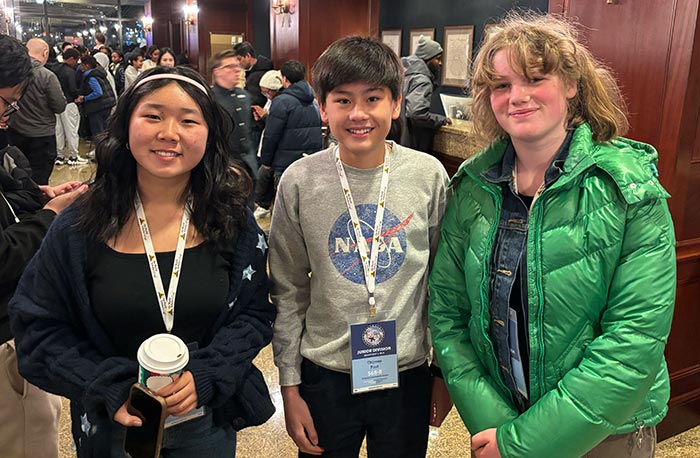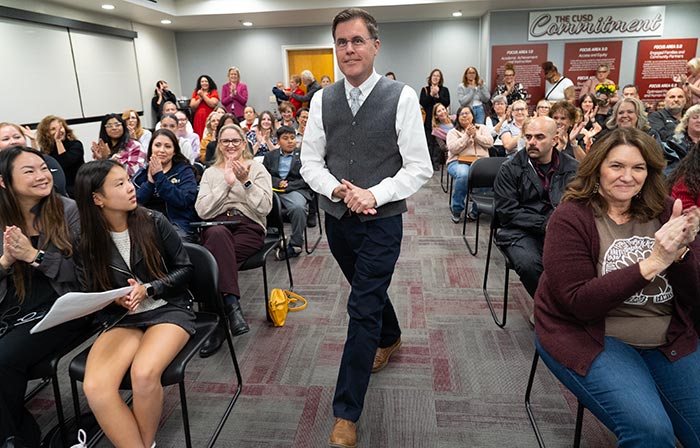Bringing the world to Chaparral
On Wednesday, a group of local elementary school students took a motorcycle ride to Taiwan and back again, stopping for a while to learn a bit about the Chinese language and culture.
No, it isn’t the plot of a new Magic School Bus book, but instead a 30-minute lesson imparted by Scripps College sophomores Maxine Tu and Vivian Zhang.
Ms. Tu and Ms. Zhang, whose time in Ken Knox’s sixth grade class at Chaparral Elementary School is their laboratory work for a class called Foreign Language and Teaching Clinic, started by telling the kids about the Chinese moon festival. Families gather outside on a mid-autumn night to appreciate the full moon, spend time with one another and snack on moon cakes filled with red bean, lotus seed paste or salted egg yolks.
After sampling a wedge of moon cake, the students “motored” eastward, hands on imaginary handlebars as they counted to three in Chinese: “Yi, vroom! Er, vroom! San, vroom!”
The preteens were then immersed in Chinese as Ms. Tu and Ms. Zhang taught them the names of the four seasons accompanied by PowerPoint slides and hand movements. While repeating the word for fall, qui tian, the students were encouraged to move one hand gently downward, fluttering it from side-to-side like an autumn leaf. For summer, xia tian, the kids mimed fanning their faces to combat the heat.
It’s all part of a teaching method called TPR (total physical response), according to the volunteer teachers’ professor, Thierry Boucquey: “The brain retains words much better if they are taught with a movement, sound or picture.”
Mr. Boucquey has been a professor of French and humanities at Scripps for 28 years. In the 18 years since he founded his teaching clinic course, his students have paired up to teach foreign languages to Chaparral upper graders. Any number of languages can and have been introduced—from Botswana’s Setswana to Arabic to German—providing he has two students in his class that are fluent in the language.
Ms. Tu and Ms. Zhang are in the midst of a 10-week course with their sixth graders. They teach on Mondays and Tuesdays. Then, on Wednesday, they return to their classroom to prepare for their coming week’s lessons and to have footage of their time in the classroom critiqued.
Earlier in the semester, they started off with three weeks of pedagogical training, beginning with a quick sample immersion class taught by Mr. Boucquey in Flemish. He was born in Belgium where he grew up speaking both Dutch and French.
He is a huge proponent of language education, the sooner the better. He says we do things wrong in the United States. Our students don’t start learning a foreign language until junior high or high school. Researchers say that the ideal time to learn a second language ends at nine, Mr. Boucquey said.
Still, you can do it at any age, and it’s a worthwhile endeavor. He quotes Charlemagne, who said, “To have another language is to possess a second soul.”
He believes that the acquisition of new words isn’t the end-all when it comes to language instruction.
“Teaching language is an excuse to teach culture,” he said.
On Monday, Alena Dollar and Liya Rabkina focused on transportation, namely train travel. As they instructed Jessica Uy’s fifth graders, they organized their lesson around a theme: Russia’s many metro stations, which are elaborate in their architecture and decoration, almost like a museum.
The young women brought some decided charisma to the class. Ms. Dollar was dressed in a blue Russian folk dress and headpiece fit for a fairytale and she and Ms. Rabkina introduced playful pantomimes (for the word ballet, the students did arabesques and other dance moves with varying degrees of grace).
Along with charismatic lessons in language, Ms. Dollar and Ms. Rabkina, who were born in Moscow and St. Petersburg, respectively, are seeking to share some of the Russian ethos with the children.
“We’ve been trying to point out the similarities of Russian and American culture while pointing out differences,” said Ms. Dollar.
Take the expression of mood and emotion. Americans have a love affair with smiling. As the late comedian Phyllis Diller once said, “A smile is a curve that sets everything straight.”
Russians, by contrast, save their smiles for moments of true joy and humor, according to Ms. Dollar. “Even though you’re not smiling, it doesn’t mean you’re not happy. You don’t always have to show your teeth.”
What is the same with people from all over the globe is that it can be daunting to tackle a new language. Ms. Tu hails from Taiwan, went to a Chinese private school until third grade and then switched to an English-speaking international school, and so she gets it.
“The challenge is that when you ask students questions, they know the answer but are afraid to say it. They’re afraid to get it wrong,” she said.
Moments of fear aside, the Roadrunners are enjoying their language classes, which also include sections in Korean, Spanish, Japanese and French.
“It’s fun, because we get to learn about another culture that’s not ours,” said fifth grader Madison Clark.
Mr. Knox has welcomed Mr. Boucquey’s protégés to his classroom since the program began. Over the years, he has stepped aside while they have tutored his students in Hindi, Spanish, French, Japanese and Farsi as well as Chinese.
“I love the fact that these wonderful college students can come in and expose my students to something they don’t usually get,” Mr. Knox said.
The elementary school students may not acquire fluency, but they gain something even more important, according to Mr. Boucquey.
“What the school has told me is that one of the biggest impacts of the language classes is that they have encouraged the children’s tolerance for foreign language and culture,” he said.
—Sarah Torribio
storribio@claremont-courier.com










0 Comments